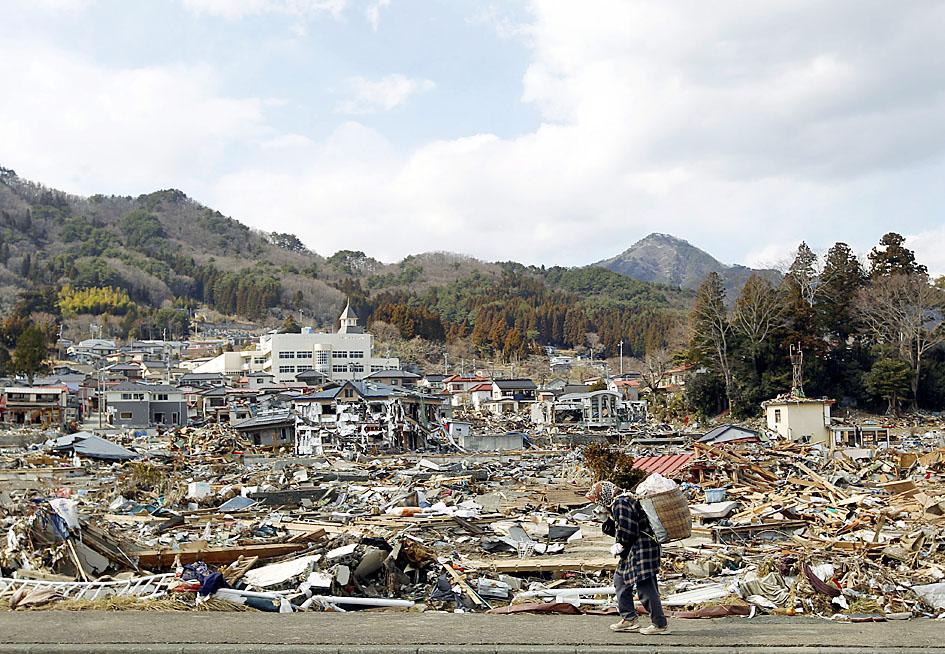A team of Taiwanese experts are to travel to Japan to examine Tokyo’s plans to release contaminated water from the disabled Fukushima Dai-ichi nuclear power plant into the ocean, the Atomic Energy Council said on Monday.
The team would likely make the trip by the end of this year, council Minister Hsieh Shou-shing (謝曉星) said, adding that Tokyo has agreed to the trip in principle.
The team is similar to an investigative task force led by the International Atomic Energy Agency (IAEA) that would also investigate Japan’s plans, Hsieh told reporters after briefing lawmakers on the matter at the Legislative Yuan.

Photo: EPA
IAEA officials have the authority to enter the power plant’s premises to inspect the work being conducted there, and the Taiwanese team would carry out an on-site inspection covering the same items on the IAEA’s itinerary, including water release information and monitoring measures, Hsieh said.
Some IAEA representatives have already visited Japan and the agency plans to send its investigative team by the end of the year, he added.
The council has been coordinating with the Ministry of Foreign Affairs and Taiwan’s representative office in Japan to negotiate the planned visit with Japanese officials, he said.
Japan has announced that it would release more than 1 million tonnes of contaminated water from the crippled power plant into the sea, beginning in about two years.
Tokyo Electric Power Co, which operates the plant, would treat and dilute the contaminated water before discharging it, Japan said.
The filtering process would remove most radioactive elements from the water, leaving only tritium, news media have reported.
The IAEA has come up with a timetable for procedures and measures regarding the release of the water, and the council would map out its plan in line with the IAEA’s timetable, despite Taiwan not being included in the UN agency’s investigative task force, Hsieh said.
Taiwan has banned food imports from five Japanese prefectures — Fukushima, Ibaraki, Tochigi, Gunma and Chiba — since the Fukushima Dai-ichi nuclear disaster on March 11, 2011.
Since the disaster, it has also subjected nine categories of Japanese food products from other parts of Japan to batch-by-batch border inspections for radioactive residue.
About 175,000 items have since been tested, government data showed.
Asked by a lawmaker whether Taiwan has enough capacity to increase tests for radioactive residue if it resumes food product imports from the five prefectures, Hsieh said that the nation’s testing capacity outstrips annual demand by about three times.
Preparations for resuming imports have been made over the past few years, he said.
The government is considering lifting the ban following its application to join the Japan-led Comprehensive and Progressive Agreement for Trans-Pacific Partnership, one of the world’s biggest trade blocs.
The bloc represents a market of 500 million people and accounts for 13.5 percent of global trade.

SHIPS, TRAINS AND AUTOMOBILES: The ministry has announced changes to varied transportation industries taking effect soon, with a number of effects for passengers Beginning next month, the post office is canceling signature upon delivery and written inquiry services for international registered small packets in accordance with the new policy of the Universal Postal Union, the Ministry of Transportation and Communications said yesterday. The new policy does not apply to packets that are to be delivered to China, the ministry said. Senders of international registered small packets would receive a NT$10 rebate on postage if the packets are sent from Jan. 1 to March 31, it added. The ministry said that three other policies are also scheduled to take effect next month. International cruise ship operators

NUMBERS IMBALANCE: More than 4 million Taiwanese have visited China this year, while only about half a million Chinese have visited here Beijing has yet to respond to Taiwan’s requests for negotiation over matters related to the recovery of cross-strait tourism, the Tourism Administration said yesterday. Taiwan’s tourism authority issued the statement after Chinese-language daily the China Times reported yesterday that the government’s policy of banning group tours to China does not stop Taiwanese from visiting the country. As of October, more than 4.2 million had traveled to China this year, exceeding last year. Beijing estimated the number of Taiwanese tourists in China could reach 4.5 million this year. By contrast, only 500,000 Chinese tourists are expected in Taiwan, the report said. The report

Temperatures are forecast to drop steadily as a continental cold air mass moves across Taiwan, with some areas also likely to see heavy rainfall, the Central Weather Administration (CWA) said. From today through early tomorrow, a cold air mass would keep temperatures low across central and northern Taiwan, and the eastern half of Taiwan proper, with isolated brief showers forecast along Keelung’s north coast, Taipei and New Taipei City’s mountainous areas and eastern Taiwan, it said. Lows of 11°C to 15°C are forecast in central and northern Taiwan, Yilan County, and the outlying Kinmen and Lienchiang (Matsu) counties, and 14°C to 17°C

STEERING FAILURE: The first boat of its class is experiencing teething issues as it readies for acceptance by the navy, according to a recent story about rudder failure The Hai Kun (海鯤), the nation’s first locally built submarine, allegedly suffered a total failure of stern hydraulic systems during the second round of sea acceptance trials on June 26, and sailors were forced to manually operate the X-rudder to turn the submarine and return to port, news Web site Mirror Daily reported yesterday. The report said that tugboats following the Hai Kun assisted the submarine in avoiding collisions with other ships due to the X-rudder malfunctioning. At the time of the report, the submarine had completed its trials and was scheduled to begin diving and surfacing tests in shallow areas. The X-rudder,